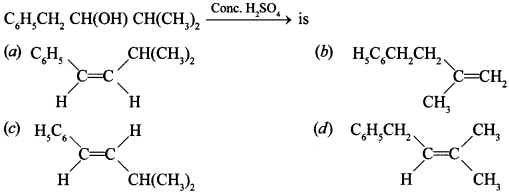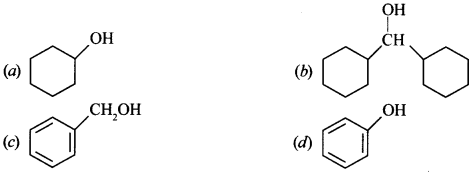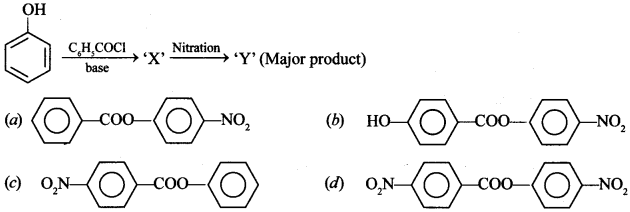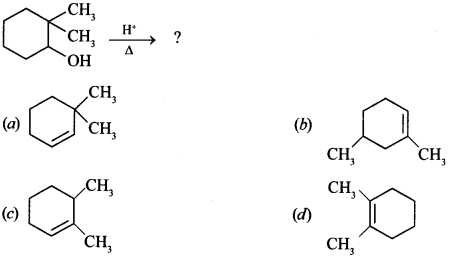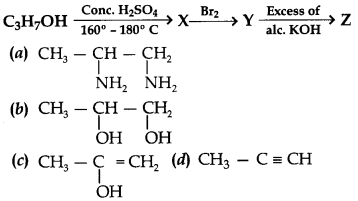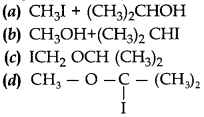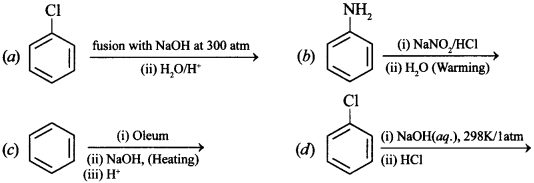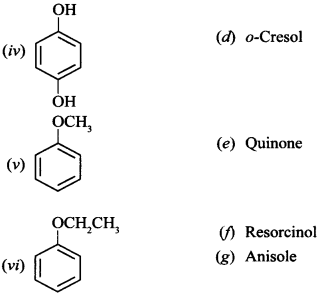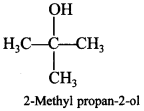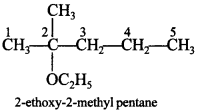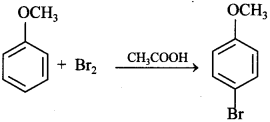Free PDF Download of CBSE Chemistry Multiple Choice Questions for Class 12 with Answers Chapter 12 Aldehydes, Ketones, and Carboxylic Acids. Chemistry MCQs for Class 1 Chapter Wise with Answers PDF Download was Prepared Based on Latest Exam Pattern. Students can solve NCERT Class 12 Chemistry Aldehydes, Ketones and Carboxylic Acids MCQs Pdf with Answers to know their preparation level.
Aldehydes, Ketones and Carboxylic Acids Class 12 Chemistry MCQs Pdf
Chemistry MCQ Questions for Class 12 Pdf Question 1.

Answer/Explanation
Answer: d
Explaination:

2. Reduction of aldehydes and ketones into hydrocarbons using zinc amalgam and cone. HCl is called:
(a) Cope reduction
(b) Dow reduction
(c) Wolff Kishner reduction
(d) Clemensen reduction
Answer/Explanation
Answer: d
Explaination:

Chemistry MCQs for Class 12 Chapter wise Pdf Question 3. Acetophenone when reacted with base C2H5—ONa, yields a stable product:

Answer/Explanation
Answer: d
Explaination:

Chemistry MCQs for Class 12 Chapterwise Question 4.

reacts with ch1oobenzene in presence of conc. H2SO4 produces


Answer/Explanation
Answer: c
Explaination:
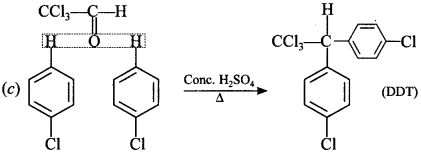
Chemistry MCQs for Class 12 with Answers Pdf Question 5. Propanoic acid with Br2/P4 yields a dibromo product. The structure will be

Answer/Explanation
Answer: c
Explaination: (c) ∵ α-hydrogens are replaced by Br atoms.
Chemistry MCQs for Class 12 Question 6.
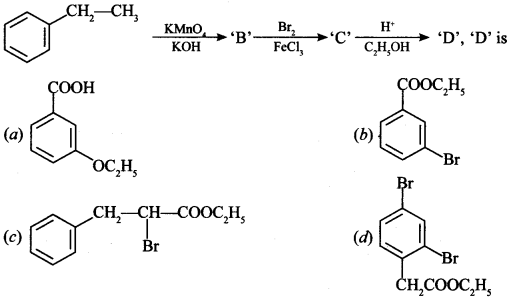
Answer/Explanation
Answer: b
Explaination:

7. CH3CHO and C6H5 CH2CHO can be distinguished chemically by
(a) Benedict’s test
(b) Iodoform test
(c) Tollen’s reagent test
(d) Fehling’s solution test
Answer/Explanation
Answer: b
Explaination:

8.

Answer/Explanation
Answer: c
Explaination:

9. Which is most reactive towards Nucleophilic substitution reaction?
(a) Benzaldehyde
(b) Acetophenone

Answer/Explanation
Answer: c
Explaination:
(c) ∵ Nitro group is electron withdrawing.
10. Which of the following is not soluble in NaHCO3?
(a) 2, 4, 6-Trinitrophenol
(b) Benzoic acid
(c) o-Nitrophenol
(d) Benzene sulphonic acid
Answer/Explanation
Answer: c
Explaination: (c) o-Nitrophenol is weakly acidic.
11. A single compound of the structure

is obtained from ozonolysis of which of the following compound?

Answer/Explanation
Answer: c
Explaination:

12. Which among the given molecules can exhibit tautomerism?

(a) III only
(b) Both I and III
(c) Both I and II
(d) Both II and III
Answer/Explanation
Answer: a
Explaination:

13. The product formed by the reaction of an aldehyde with a primary amine is
(a) Carboxylic acid
(b) Aromatic acid
(c) SchifTs base
(d) Ketone
Answer/Explanation
Answer: c
Explaination:

14.

Answer/Explanation
Answer:
Explaination:
15. The correct order of increasing acidic strength is ____________ . [NCERT Exemplarl
(a) Phenol < Ethanol < Chloroacetic acid < Acetic acid
(b) Ethanol < Phenol < Chloroacetic acid < Acetic acid
(c) Ethanol < Phenol < Acetic acid < Chloroacetic acid
(d) Chloroacetic acid < Acetic acid < Phenol < Ethanol
Answer/Explanation
Answer: c
Explaination:
(c) It is because C2H5O⊖ is least stable and chloroacetate ion is most stable.
16. Compound

can be prepared by the reaction of __________ . [NCERT Exemplar]
(a) Phenol and benzoic acid in the presence of NaOH
(b) Phenol and benzoyl chloride in the presence of pyridine
(c) Phenol and benzoyl chloride in the presence of ZnCl2
(d) Phenol and benzaldehyde in the presence of palladium
Answer/Explanation
Answer:
Explaination:

17. Cannizaro’s reaction is not given by ____________ . [NCERT Exemplar]

Answer/Explanation
Answer: d
Explaination: (d) Because it has α-hydrogen.
Note: In the following questions two or more options may be correct. (Q.18 to Q.21)
18. Which of the following compounds do not undergo aldol condensation? [NCERT Exemplar]

Answer/Explanation
Answer:
Explaination:
(b) and (d) because these do not have α-hydrogen.
19. Treatment of compound

with NaOH solution yields [NCERT Exemplar]
(a) Phenol
(b) Sodium phenoxide
(c) Sodium benzoate
(d) Benzophenone
Answer/Explanation
Answer:
Explaination:

20. Benzophenone can be obtained by ____________ . [NCERT Exemplar]
(a) Benzoyl chloride + Benzene + AlCl3
(b) Benzoyl chloride + Diphenyl cadmium
(c) Benzoyl chloride + Phenyl magnesium chloride
(d) Benzene + Carbon monoxide + ZnCl2
Answer/Explanation
Answer:
Explaination:

21. Correct order of decreasing reactivity of nucleophillic addition in case of HCHO, CH3CHO and CH3COCH3 is
(a) CH3 COH3 > CH3CHO > HCHO
(b) HCHO > CH3CHO > CH3COCH3
(c) CH3COCH3 > HCHO > CH3CHO
(d) CH3CHO > HCHO > CH3COCH3
Answer
Answer: b
22. The reagent with which both acetaldehyde and acetone react easily is
(a) Fehling’s reagent
(b) Grignard’s reagent
(c) Schiff’s reagent
(d) Tollen’s reagent
Answer
Answer: b
23. ![]()
The above chemical reaction represents
(a) Rosenmund’s reaction.
(b) Cannizaro’s reaction.
(c) Kolbe’s reaction,
(d) Etard’s reaction.
Answer
Answer: b
24. For distinction between pentan-2-one and pentan-3-one, which reagent can be employed?
(a) K2Cr2O7/H+
(b) ZnHg/HCl
(c) NaOH/I2
(d) AgNO3/NH4OH
Answer
Answer: c
25. Which of the following will undergo aldol condensation?
(a) CH2 = CHCHO
(b) CH = CCHO
(c) C6H5CHO
(d) CH3CH2CHO
Answer
Answer: d
26. Compound ‘A’ C5H10O forms a phenyl hydrazone and gives a negative Tollen’s reagent test and iodoform test. On reduction with Zn+Hg/HCl, compound A gives n-pentane. The compound ‘A’ is
(a) Primary alcohol
(b) Aldehyde
(c) Secondary alcohol
(d) Ketone
Answer
Answer: b
27. Tert Butyl alcohol can be obtained by treating with CH3MgBr followed by hydrolysis
(a) HCHO
(b) CH3CHO
(c) CH3COCH3
(d) CH3CH2CHO
Answer
Answer: c
28.
(a) 3-Nitrosalicylic acid
(b) 3, 5-Dinitrosalicylic acid
(c) m-Nitrobenzoic acid
(d) Picric acid
Answer
Answer: d
29. The end product (C) in the following reaction sequence is

(a) CH3 — CH2 COONa
(b) CH2 = CH2
(c) CH3 — CH3
(d) CH2 = CH-COOH
Answer
Answer: b
30. Benzone acid is weaker than ……… but stronger than ………..
(a) p-toluic acid, o-toluic acid
(b) p-nitrobenzoic acid, p-toluic acid
(c) acetic acid, formic acid
(d) fomic acid, acetic acid
Answer
Answer: d
31. Which of the following is the correct representation for intermediate of nucleophilic addition reaction to the given carbonyl compound (A): [NCERT Exemplar]

Answer/Explanation
Answer:
Explaination:
(a) and (b) are correct intermediate.
32. Match the common names given in Column I with the IUPAC names given in Column II. [NCERT Exemplar]
| Column I (Common names) | Column II (IUPAC names) |
| (a) Cinnamaldehyde | (i) Pentanal |
| (b) Acetophenone | (ii) Prop-2-enal |
| (c) Valeraldehyde | (iii) 4-Methylpent-3-en-2-one – |
| (d) Acrolein | (iv) 3-Phenylprop-2-enal |
| (e) Mesityl oxide | (v) 1-Phenylethanone |
Answer/Explanation
Answer:
Explaination:
(a) (iv)
(b) (v)
(c) (i)
(d) (ii)
(e) (iii)
33. Match the acids given in Column I with their correct IUPAC names given in Column II. [NCERT Exemplar]
| Column I (Acids) | Column II (IUPAC names) |
| (a) Phthalic acid | (i) Hexane-1,6-dioic acid |
| (b) Oxalic acid | (ii) Benzene-1,2-dicarboxylic acid |
| (c) Succinic acid | (iii) Pentane-1,5-dioic acid |
| (d) Adipic acid | (iv) Butane-1,4-dioic acid |
| (e) Glutaric acid | (v) Ethane-1,2-dioic acid |
Answer/Explanation
Answer:
Explaination:
(a) (ii)
(b) (v)
(c) (iv)
(d) (i)
(e) (iii)
34. Match the reactions given in Column I with the suitable reagents given in Column II. [NCERT Exemplar]
| Column I (Reactions) | Column II (Reagents) |
| (a) Benzophenone → Diphenylmethane | (i) LiAlH4 |
| (b) Benzaldehyde → 1-Phenylethanol | (ii) DIBAL—H |
| (c) Cyclohexanone → Cyclohexanol | (iii) Zn(Hg)/Conc. HCl |
| (d) Phenyl benzoate → Benzaldehyde | (iv) CH3MgBr |
Answer/Explanation
Answer:
Explaination:
(a) (iii)
(b) (iv)
(c) (i)
(d) (ii)
Note: In the following questions a statement of assertion followed by a statement of reason is given. Choose the correct answer out of the following choices. (Q.25 to Q.28)
(a) Assertion and reason both are correct and reason is correct explanation of assertion.
(b) Assertion and reason both are wrong statements.
(c) Assertion is correct but reason is wrong statement.
(d) Assertion is wrong but reason is correct statement.
(e) Assertion and reason both are correct statements but reason is not correct explanation of assertion.
35. Assertion: Formaldehyde is a planar molecule.
Reason: It contains sp² hybridised carbon atom. [NCERT Exemplar]
Answer/Explanation
Answer:
Explaination:
(a) Assertion and reason both are correct and reason is correct explanation of assertion.
36. Assertion: Compounds containing —CHO group are easily oxidised to corresponding carboxylic acids. Reason: Carboxylic acids can be reduced to alcohols by treatment with LiAlH4. [NCERT Exemplar]
Answer/Explanation
Answer:
Explaination:
(e) Assertion and reason both are correct statements but reason is not correct explanation of assertion.
37. Assertion: The a-hydrogen atom in carbonyl compounds is less acidic.
Reason: The anion formed after the loss of a-hydrogen atom is resonance stabilised. [NCERT Exemplar]
Answer/Explanation
Answer:
Explaination:
(d) Assertion is wrong but reason is correct statement.
38. Assertion: Aromatic aldehydes and formaldehyde undergo Cannizaro reaction.
Reason: Aromatic aldehydes are almost as reactive as formaldehyde. [NCERT Exemplar]
Answer/Explanation
Answer:
Explaination:
(c) Assertion is correct but reason is wrong statement.
39. Pentan-2-one can be distinguished from pentan-3-one by ____________ test.
Answer/Explanation
Answer:
Explaination: Iodoform
40. The pKa of acetic acid is ____________ than that of phenol.
Answer/Explanation
Answer:
Explaination: lower
41. Benzoate ion is more ____________ than acetate ion.
Answer/Explanation
Answer:
Explaination: stable
42. Formic acid does not undergo HVZ reaction because it does not have ____________ .
Answer/Explanation
Answer:
Explaination: a-hydrogen
43. Phenol does not liberate CO2 with NaHCO3. [True/False]
Answer/Explanation
Answer:
Explaination: True, because it is weakly acidic.
44. All aldehydes turn SchifTs reagent pink. [True/False]
Answer/Explanation
Answer:
Explaination: True
45.

Answer/Explanation
Answer:
Explaination: True
46.  [True/False]
[True/False]
Answer/Explanation
Answer:
Explaination: True
47. Write IUPAC name of the following compound: [Delhi 2014(C)]

Answer/Explanation
Answer:
Explaination: 2-Methyl propanal.
48. Write the structure of 3-hydroxybutanal. [Foreign 2013]
Answer/Explanation
Answer:
Explaination:

49. Write the structure of 3-methylbutanal. [Delhi 2013]
Answer/Explanation
Answer:
Explaination:

50. Write the IUPAC name of the compound. [Delhi 2014]

Answer/Explanation
Answer:
Explaination: 3-Amino butanal.
51. Write the IUPAC name of the following compound: [Chennai 2019]

Answer/Explanation
Answer:
Explaination:

52. Write the structure of the following compound: 3-oxopentanal. [Foreign 2011]
Answer/Explanation
Answer:
Explaination:

53. Write the structure of p-Methylbenzaldehyde molecule. [AI 2014; Delhi 2013]
Answer/Explanation
Answer:
Explaination:

54. Write the IUPAC name of the following compound: [Foreign 2014]

Answer/Explanation
Answer:
Explaination: 2-Hydroxy benzaldehyde.
55. Write the structure of 4-chloropentan-2-one. [AI 2014; Delhi 2013]
Answer/Explanation
Answer:
Explaination:

56. Write the structure of 4-methylpent-3-en-2-one. [Foreign 2013]
Answer/Explanation
Answer:
Explaination:

57. Write the IUPAC name of the compound. [Delhi 2014]
![]()
Answer/Explanation
Answer:
Explaination: 4-Hydroxy-2-pentanone.
58. Write the IUPAC name of [AI 2011(C)]

Answer/Explanation
Answer:
Explaination: 4-Methylpent-3-en-2-one
59. How will you convert 3-hydroxybutanal from ethanol? Write chemical reaction.
Answer/Explanation
Answer:
Explaination:

60. Complete the following chemical reaction:
![]()
Answer/Explanation
Answer:
Explaination:

61. Write the chemical equations for the following chemical reactions:
Benzonitrile is converted to acetophenone.
Answer/Explanation
Answer:
Explaination:

62. Ethanal is soluble in water. Why? [AI 2011]
Answer/Explanation
Answer:
Explaination:
63. Which aldehyde does not give Fehling’s solution test?
Answer/Explanation
Answer:
Explaination:
64. Write the IUPAC name of compound. [Delhi 2014]
![]()
Answer/Explanation
Answer:
Explaination:
65. Write the IUPAC name of the following: [Delhi 2011(C)]
![]()
Answer/Explanation
Answer:
Explaination:
66. Write the structure of 2-hydroxy benzoic acid. [AI 2014]
Answer/Explanation
Answer:
Explaination:

67. Write the structural formula of 2-phenylethanoic acid. [Foreign 2013]
Answer/Explanation
Answer:
Explaination:
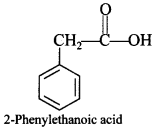
68. Write the IUPAC name of [AI 2011(C)]

Answer/Explanation
Answer:
Explaination: 3-Bromo-5-chlorobenzoic acid
69. Write IUPAC name of the following compound: [AI 2014(C)]

Answer/Explanation
Answer:
Explaination: Isopropyl ethanoate (1-methyl ethyl propanoate).
70. Write the IUPAC name of [Delhi 2011(C)]

Answer/Explanation
Answer:
Explaination: 3, 5-Dimethylphenylethanoate
71. Higher carboxylic acids are practically insoluble in water. Give reason.
Answer/Explanation
Answer:
Explaination:
This is due to the increased hydrophobic interaction of hydrocarbon part.
72. Arrange the following in increasing order of acidic character:
HCOOH, ClCH2COOH, CF3COOH, CCl3COOH
Answer/Explanation
Answer:
Explaination:
HCOOH < ClCH2COOH < CCl3COOH < CF3COOH
73. Compare the strength of following acids:
(i) Formic acid,
(ii) Acetic acid,
(iii) Benzoic acid.
Answer/Explanation
Answer:
Explaination:
HCOOH > C6H5COOH > CH3COOH
74. Give some industrial uses of methanoic acid.
Answer/Explanation
Answer:
Explaination:
It is used in rubber, textile, leather, dying and electroplating industries.
75. Draw the structural formula of 1-phenylpropan-l-one molecule.
Answer/Explanation
Answer:
Explaination:

We hope the given Chemistry MCQs for Class 12 with Answers Chapter 12 Aldehydes, Ketones and Carboxylic Acids will help you. If you have any query regarding CBSE Class 12 Chemistry Aldehydes, Ketones and Carboxylic Acids MCQs Pdf, drop a comment below and we will get back to you at the earliest.



